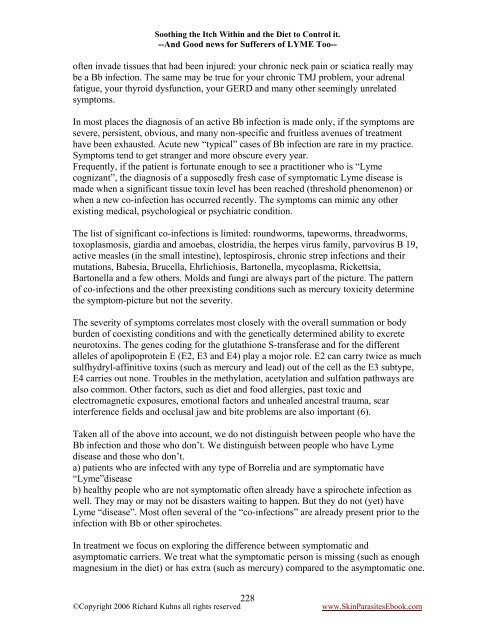Soothing the - Itchy Skin Parasites
Soothing the - Itchy Skin Parasites
Soothing the - Itchy Skin Parasites
You also want an ePaper? Increase the reach of your titles
YUMPU automatically turns print PDFs into web optimized ePapers that Google loves.
<strong>Soothing</strong> <strong>the</strong> Itch Within and <strong>the</strong> Diet to Control it.<br />
--And Good news for Sufferers of LYME Too--<br />
often invade tissues that had been injured: your chronic neck pain or sciatica really may<br />
be a Bb infection. The same may be true for your chronic TMJ problem, your adrenal<br />
fatigue, your thyroid dysfunction, your GERD and many o<strong>the</strong>r seemingly unrelated<br />
symptoms.<br />
In most places <strong>the</strong> diagnosis of an active Bb infection is made only, if <strong>the</strong> symptoms are<br />
severe, persistent, obvious, and many non-specific and fruitless avenues of treatment<br />
have been exhausted. Acute new “typical” cases of Bb infection are rare in my practice.<br />
Symptoms tend to get stranger and more obscure every year.<br />
Frequently, if <strong>the</strong> patient is fortunate enough to see a practitioner who is “Lyme<br />
cognizant”, <strong>the</strong> diagnosis of a supposedly fresh case of symptomatic Lyme disease is<br />
made when a significant tissue toxin level has been reached (threshold phenomenon) or<br />
when a new co-infection has occurred recently. The symptoms can mimic any o<strong>the</strong>r<br />
existing medical, psychological or psychiatric condition.<br />
The list of significant co-infections is limited: roundworms, tapeworms, threadworms,<br />
toxoplasmosis, giardia and amoebas, clostridia, <strong>the</strong> herpes virus family, parvovirus B 19,<br />
active measles (in <strong>the</strong> small intestine), leptospirosis, chronic strep infections and <strong>the</strong>ir<br />
mutations, Babesia, Brucella, Ehrlichiosis, Bartonella, mycoplasma, Rickettsia,<br />
Bartonella and a few o<strong>the</strong>rs. Molds and fungi are always part of <strong>the</strong> picture. The pattern<br />
of co-infections and <strong>the</strong> o<strong>the</strong>r preexisting conditions such as mercury toxicity determine<br />
<strong>the</strong> symptom-picture but not <strong>the</strong> severity.<br />
The severity of symptoms correlates most closely with <strong>the</strong> overall summation or body<br />
burden of coexisting conditions and with <strong>the</strong> genetically determined ability to excrete<br />
neurotoxins. The genes coding for <strong>the</strong> glutathione S-transferase and for <strong>the</strong> different<br />
alleles of apolipoprotein E (E2, E3 and E4) play a mojor role. E2 can carry twice as much<br />
sulfhydryl-affinitive toxins (such as mercury and lead) out of <strong>the</strong> cell as <strong>the</strong> E3 subtype,<br />
E4 carries out none. Troubles in <strong>the</strong> methylation, acetylation and sulfation pathways are<br />
also common. O<strong>the</strong>r factors, such as diet and food allergies, past toxic and<br />
electromagnetic exposures, emotional factors and unhealed ancestral trauma, scar<br />
interference fields and occlusal jaw and bite problems are also important (6).<br />
Taken all of <strong>the</strong> above into account, we do not distinguish between people who have <strong>the</strong><br />
Bb infection and those who don’t. We distinguish between people who have Lyme<br />
disease and those who don’t.<br />
a) patients who are infected with any type of Borrelia and are symptomatic have<br />
“Lyme”disease<br />
b) healthy people who are not symptomatic often already have a spirochete infection as<br />
well. They may or may not be disasters waiting to happen. But <strong>the</strong>y do not (yet) have<br />
Lyme “disease”. Most often several of <strong>the</strong> “co-infections” are already present prior to <strong>the</strong><br />
infection with Bb or o<strong>the</strong>r spirochetes.<br />
In treatment we focus on exploring <strong>the</strong> difference between symptomatic and<br />
asymptomatic carriers. We treat what <strong>the</strong> symptomatic person is missing (such as enough<br />
magnesium in <strong>the</strong> diet) or has extra (such as mercury) compared to <strong>the</strong> asymptomatic one.<br />
228<br />
©Copyright 2006 Richard Kuhns all rights reserved www.<strong>Skin</strong><strong>Parasites</strong>Ebook.com


